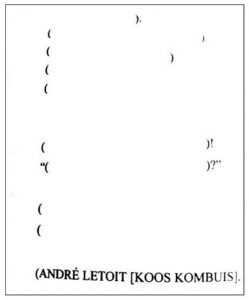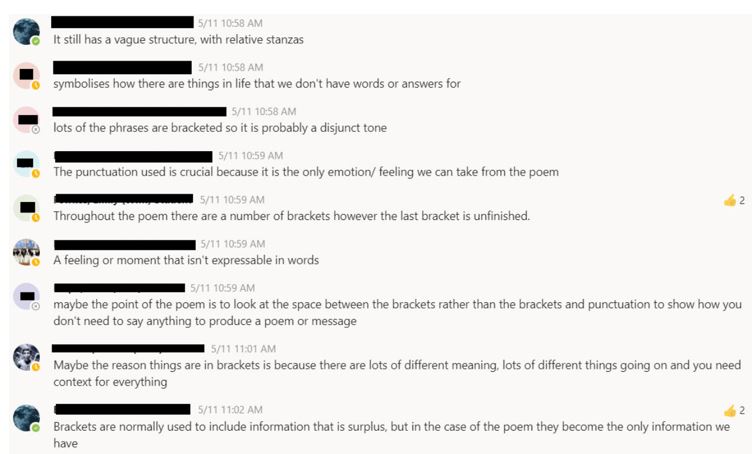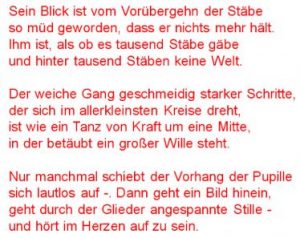Imogen (Year 9) looks at the connection between money, power and the monarchy in this short presentation arguing as to whether we can see money as the root of all evil.
Watch below:
Imogen (Year 9) looks at the connection between money, power and the monarchy in this short presentation arguing as to whether we can see money as the root of all evil.
Watch below:
Miss Lucinda Gilchrist, Head of English, considers the virtues of being ‘stuck’, and how this can help pupils tackle challenging tasks with more confidence.
Carol Dweck’s influential work on growth mindset has become common parlance across schools now, and we know that helping pupils develop grit, perseverance and resilience is key to supporting them in their learning. A growth mindset is one in which ability is seen as ‘changeable’, and which ‘can be developed through learning’ (Dweck, 2006), rather than innate or fixed. As teachers, we want pupils to be able to reframe their thinking about things they struggle with to develop a growth mindset. We therefore provide scaffolds and supports to ease pupils into the ‘zone of proximal development’ and enable them to see smaller successes on the path to larger ones.
However, small and incremental scaffolds may actually serve to make them more reliant on the support from their teachers than on their own reasoning. An example of this: as part of some of my MA action research, I declared ‘war’ on the PEE/PEA structure, which I knew pupils had become too reliant on and which was making their writing too mechanical, and many of them simply relied on another acronym they had learnt in the past. By easing pupils into a task too gently, we run this risk: ‘if a task does not puzzle us at all, then it is not a problem; it is just an exercise’[1].
We therefore sometimes need to remove even more of the support structures, and defamiliarise pupils even further in order to make them less reliant on the scaffolds we put in place, and make them more aware of the ways in which they can get themselves unstuck, helping them to understand what to do when they don’t know what to do. We can expose them to challenges which they might consider beyond their ‘zone of proximal development’ – be this a new style of Mathematics problem, an unusual context for a theory in the Sciences, or a piece of music unlike anything they’ve heard before.
Many students of English Literature at KS4 are anxious about the concept of ‘unseen’ – the part of the examination where pupils have to write an essay about a text they have never seen before. It’s particularly challenging with poetry: a poem is often by nature oblique and abstract, resisting an easy answer. While this is what we love about poetry, it can be frustrating for some pupils who want the ‘right’ answer! Pupils who find developing their own interpretations of texts hard sometimes rely on ‘getting’ the notes about texts, and thereby the ‘right’ answer, rather than developing the habits they need to be able to respond to any text, whether one they have encountered before or not. This is understandable: while English teachers will argue that all texts are ‘unseen’ before they are studied, pupils can become used to the scaffold of discussing with pairs or small groups, and the reassurance that, at the end, the teacher would eventually confirm the ‘right’ response by guiding the discussion and asking purposeful questions.
As Angela Duckworth says in Grit, ‘We prefer our excellence fully formed’ (2016). We would prefer to show the world the successful final outcome, rather than the training and experimenting, which means that committing pen to paper and articulating an interpretation of an unseen poem, or even just verbally expressing an idea in class discussion, could make unseen poetry a locus of fear and failure where pupils may feel intimidated by the myth that some people just ‘get it’ and others don’t, rather than seeing it as an enjoyable challenge. When I surveyed my Year 10 class about what they felt the biggest challenges in responding to unseen poetry were, several of their responses focused on the idea of a fixed, or correct interpretation – they were concerned about “analysing the text correctly” or finding “the right message/s of the poem”. While many of them commented that they liked “reading new poems” and to have a “fresh start and use things we’ve learnt from other poems”, it is interesting that the pressure to ‘get it right’ still prevails.
So I decided to give my pupils a challenge which would deliberately make them feel stuck. As a starter activity just as we started our unseen poetry unit, I gave them a poem which was on a Cambridge University end of year examination in 2014, and which consists only of punctuation[2]:

They were definitely daunted by this – in a survey after the lesson I asked them how they felt when they saw it:

They were beginning to notice some really interesting ideas: the open-ended nature of the poem because of the unfinished last section, the implications of the punctuation marks which were there, and the fact that the lines were bracketed, suggesting some sort of devaluing of whatever words might have been inside them. I then revealed the title of the poem: ‘Tipp-Ex Sonata’, and explained that the poet, Koos Kombuis, was a South African performer and writer. With additional context, and using another pupil’s observation about apartheid, they then made some even more impressive deductions:

They had got very close to what Koos Kombuis had said about the poem himself: that it’s a protest against censorship of anti-apartheid voices in South Africa. So far, so good: the pupils had proved that they could reframe their thinking and use different clues to help them analyse the poem.
I then showed the pupils a poem in German:

This, naturally presented pupils with a different problem. However, they could identify rhyme and internal rhymes, alliteration and sound iconicity, and when they heard the poem aloud they could hear the regular, almost monotonous iambic pentameter. They identified that the first and last words of the poem were the same (although one is a pronoun and the other is a verb, they were using the right sort of reasoning!), and made an interesting point about the poem having a cyclical structure as a result. We spoke about how these gave the impression of something enclosed or making repeated movements – and of course, they were actually very close! This poem, ‘Der Panther’ by Rainer Maria Rilke[3], is about a panther, trapped in a cage and moving around in tiny circles as his mind calcifies. Without realising it, and without knowing any of the words, the pupils managed to understand this poem at a surprisingly deep level.
I then asked the pupils their feelings about unseen poetry, having attempted these two poems which would have been certainly at best uncomfortable, and at worst enough to make them feel ‘stuck’:
At WHS, we are fortunate enough to teach thoughtful, perceptive and independent students, and it’s encouraging to see the ways that they engage with really tricky material, and begin to see that, if they can tackle an undergraduate exam text in Year 10, they can tackle any poem! The same strategy could be used in many subjects – a piece of artwork which doesn’t look like what someone might assume to be ‘art’, a piece of music which challenges the expectations of a particular genre, data which might seem to buck a trend in science subjects. These lessons are memorable as well: one of the girls in my Year 13 class signed up for my elective module on Sociolinguistics on the strength of the introduction to Middle English activity which she had enjoyed several months earlier! By challenging pupils’ expectations and perceptions of their own limitations, they are able to see their subjects in a broader light than the examination syllabi, make connections with wider experiences, and learn a valuable lesson about what to do when they don’t know what to do.
References and Further Reading
Duckworth, A. (2016) Grit: Why passion and resilience are the secrets to success, Vermillion.
Dweck, C. (2006) Mindset: The New Psychology of Success, Ballantine Books.
https://www.buildinglearningpower.com/2016/04/i-give-up/
https://www.buildinglearningpower.com/2016/05/getting-unstuck/
https://www.bbc.co.uk/news/blogs-magazine-monitor-27680904
http://www.thempra.org.uk/social-pedagogy/key-concepts-in-social-pedagogy/the-learning-zone-model/
[1] https://www.buildinglearningpower.com/2016/05/getting-unstuck/
[2] https://www.bbc.co.uk/news/blogs-magazine-monitor-27680904
[3] https://www.poemhunter.com/poem/the-panther/
[4] http://www.thempra.org.uk/social-pedagogy/key-concepts-in-social-pedagogy/the-learning-zone-model/
Lara (Year 8) gives a stirring argument as to why the study of Ancient History is relevant for us today.
Watch the video below:
Year 7 tell us about their school life at WHS.
Bonjour,
Je m’appelle Chloe. J’ai douze ans. Mon collège s’appelle Wimbledon High School. On a cours le lundi, le mardi, le mercredi, le jeudi et le vendredi. On commence les cours à neuf heures. On a cinq cours le matin et deux cours l’après-midi. On étudie dix-sept matières. A une heure moins cinq, c’est le déjeuner. On mange à la cantine. On finit les cours à quatre heures.
Au revoir !
Chloe
Bonjour,
Je m’appelle Abigail. J’ai douze ans. Mon collège s’appelle Wimbledon High School. On a cours le lundi, le mardi, le mercredi, le jeudi et le vendredi. On commence les cours à neuf heures moins vingt. On a cinq cours le matin et deux cours l’après-midi. A neuf heures, j’ai anglais, c’est marrant ! A dix heures vingt-cinq j’ai la récréation. On bavarde et on rigole. C’est le déjeuner à treize heures moins cinq. Je mange du poulet avec des frites et de la mousse au chocolat. A quatorze heures vingt-cinq, j’ai l’histoire. J’aime l’histoire parce que la prof est sympa. On finit les cours à seize heures, on est fatigués. J’aime mon emploi du temps, c’est très bien ! mes matières préférées sont les maths, le français, la géographie et les arts plastiques. J’aime aussi le théâtre parce que c’est drôle.
Au revoir !
Abigail

Bonjour. Je m’appelle Simonna.
Je suis âgé de douze ans. Mon collège s’appelle Wimbledon High School. Nous avons des cours le lundi, mardi, mercredi, jeudi et vendredi. Nous commençons à 8h30 le lundi et à 8h40 le mardi, mercredi, jeudi et vendredi. Nous avons la semaine a et la semaine b.
Nous avons une pause à dix heures vingt-cinq. Lundi, nous avons l’anglais et le français. Mardi j’ai une leçon de saxophone. au déjeuner je parle avec mes amis, la nourriture à la cantine est ok. Mon professeur de français est sympa et les cours sont amusants. l’histoire est ennuyeuse, je reçois beaucoup de devoirs dans l’histoire. Mon sujet préféré est l’anglais, mais je n’aime pas la musique. L’école est fantastique.
Simonna
By Lily (Year 9)
What will we be without poetry in this strange and bewildering period of lockdown?
by Anushka and Andjela (Year 8)
Je me réveille le matin, Je me lave les dents, Je me regarde dans la glace, Mais ce n’est plus pareil. Cuano hay tormenta cocino, Cuando hace sol, juego al tenis, Cuando llueve, toco la guitarra, Pero no es lo mismo. Letzten Sommer bin ich nach Spanien gefahren. Ich bin Schwimmen gegangen, Ich habe Eiscreme gegessen, Aber alles ist nun anders. Une fois par jour, je télécharge de la musique, Deux fois par jour, je parle avec mes amies, Trois fois par jour, je tchatte sur Whatsapp, Mais ce n’est plus pareil. Me gusta colegio, No me gusta qudarme en casa, Odio cuarantena, Porque nunca será lo mismo Ich lese Comics, Ich sehe Gameshows, Ich sehe Actionfilme, Aber alles ist nun anders. I miss my friends, I miss the outdoors, I miss walking to school, But it won’t be the same.
Eliza researched the life and work of the Georg Wilhelm Friedrich Hegel who was an important philosopher and influential thinker of German Idealism.
By Eliza (Year 11)
Georg Wilhelm Friedrich Hegel wurde am 27. August 1770 in Stuttgart geboren. Während seines Lebens schrieb Hegel viele lange und berühmte Bücher, darunter ‘Phänomenologie des Geistes’, das eines von Hegels wichtigsten Werken ist. Außerdem war sein Schreiben ganz schwer zu verstehen, denn er benutzte eine sehr komplizierte Sprache. Deshalb ist die Philosophie in unserer Welt viel undurchsichter als sie sein sollte und es ist schwierig, das wertvolle Wissen von Hegel zu erhalten.
Seine Bücher bestehen aus mehreren Lektionen, wobei die erste darin besteht, dass ‘wichtige Teile von uns in der Geschichte zu finden sind’. Das heißt, wenn wir in der modernen Welt auf Fehler oder Probleme stoßen, sollten wir in der Geschichte suchen, um Lösungen zu finden und herauszufinden was fehlt. Zum Beispiel müssen wir vielleicht antike griechische Artefakte ausgraben, um die Idee der Gemeinschaft zu erfassen, etwas das in unserer Zeit verloren geht.
Eine weitere Lehre von Hegel ist, dass wir aus den Ideen lernen müssen, die wir nicht mögen. Er glaubt, dass aus erschreckenden Phänomenen wertvolle Lehren gezogen werden können, zum Beispiel kann uns das blutige Konzept des Nationalismus einige gute Ideen vermitteln. Er hatte viele andere fortschrittliche Gedanken und hatte auch eine starke Wertschätzung für die Künste. Leider ist er 1831 im Alter von 61 an Cholera gestorben, aber seine Arbeit ist in unserer Welt immer wieder von großer Bedeutung.
Teaching and Learning Gem #10 – student collaboration using Miro

We know how important it is to find ways for students to connect and collaborate during GHL. Clare Roper shared with me some videos of her Year 10s working together in real time using Miro – an online collaborative platform. She put students in groups using Teams channels so that they could speak with each other as they completed the collaborative task online. She could see exactly what was going on, to support and give encouragement live.
Teams competed to order the stages of the pollination process. This video is so fun…I think Clare has a future as a sports commentator!
Clare was able to watch the different groups of students collaborating on their thinking maps and give immediate feedback. Watch here.
Miro has lots of different ways for students to collaborate. Click here to watch a short promotional video about Miro.
Alice researched this brave German theologian and resistance fighter who was executed by the Nazis in the final days of the Second World War. During his inprisonment, in moments of great darkness and fear he wrote the poignant poem “Wer bin ich?”
By Alice (Year 11)
Dietrich Bonhoeffer wurde am 4. Februar 1906 geboren. Bonhoeffer ist in einer einflussreichen Familie aufgewachsen und seine Eltern haben ihm und seinen Geschwistern eine gute Ausbildung gegeben. Dies bedeutet, dass viele seiner Geschwister auch einflussreich und wichtig wurden.
Später wurde Bonhoeffer ein wichtiger christlicher Theologe und war berühmt, weil er gegen Antisemitismus und die Nazis protestiert hat. Er wurde Pastor und lehrte Theologie in Berlin und wurde ein führender Sprecher der Bekennenden Kirche. Er wollte, dass deutsche protestantische Kirchen gegen Hitler und die Nazis protestieren.
Während des Krieges hat er in einer Widerstandsgruppe gearbeitet und hat vielen Juden geholfen, aus Deutschland in die Schweiz zu fliehen.
Sein Schwager stellte ihn der Gruppe vor, die Hitler töten wollte. Infolgedessen wurde er am 5. April 1943 (neunzehnhundertdreiundvierzig) verhaftet und ist für den Rest seines Lebens im Gefängnis geblieben. Und als sie herausgefunden haben, dass er Teil der Gruppe war, wurde er hingerichtet.
Wer bin ich? Sie sagen mir oft,
ich träte aus meiner Zelle
gelassen und heiter und fest,
wie ein Gutsherr aus seinem Schloß.
Wer bin ich? Sie sagen mir oft,
ich spräche mit meinen Bewachern
frei und freundlich und klar,
als hätte ich zu gebieten.
Wer bin ich? Sie sagen mir auch,
ich trüge die Tage des Unglücks
gleichmütig lächelnd und stolz,
wie einer, der Siegen gewohnt ist.
Bin ich das wirklich, was andere von mir sagen?
Oder bin ich nur das, was ich selbst von mir weiß?
Unruhig, sehnsüchtig, krank, wie ein Vogel im Käfig,
ringend nach Lebensatem, als würgte mir einer die Kehle,
hungernd nach Farben, nach Blumen, nach Vogelstimmen,
dürstend nach guten Worten, nach menschlicher Nähe,
zitternd vor Zorn über Willkür und kleinlichste Kränkung,
umgetrieben vom Warten auf große Dinge,
ohnmächtig bangend um Freunde in endloser Ferne,
müde und leer zum Beten, zum Denken, zum Schaffen,
matt und bereit, von allem Abschied zu nehmen?
Wer bin ich? Der oder jener?
Bin ich denn heute dieser und morgen ein andrer?
Bin ich beides zugleich? Vor Menschen ein Heuchler
Und vor mir selbst ein verächtlich wehleidiger Schwächling?
Oder gleicht, was in mir noch ist, dem geschlagenen Heer,
das in Unordnung weicht vor schon gewonnenem Sieg?
Wer bin ich? Einsames Fragen treibt mit mir Spott.
Wer ich auch bin, Du kennst mich, Dein bin ich, o Gott!
(aus: Dietrich Bonhoeffer. Widerstand und Ergebung)
Translation:
Who am I? They often tell me
I stepped from my cells confinement
Calmly, cheerfully, firmly,
Like a Squire from his country house.
Who am I? They often tell me
I used to speak to my warders
Freely and friendly and clearly,
As thought it were mine to command.
Who am I? They also tell me
I bore the days of misfortune
Equably, smilingly, proudly,
like one accustomed to win.
Am I then really that which other men tell of?
Or am I only what I myself know of myself?
Restless and longing and sick, like a bird in a cage,
Struggling for breath, as though hands were compressing my throat,
Yearning for colors, for flowers, for the voices of birds,
Thirsting for words of kindness, for neighborliness,
Tossing in expectations of great events,
Powerlessly trembling for friends at an infinite distance,
Weary and empty at praying, at thinking, at making,
Faint, and ready to say farewell to it all.
Who am I? This or the Other?
Am I one person today and tomorrow another?
Am I both at once? A hypocrite before others,
And before myself a contemptible woebegone weakling?
Or is something within me still like a beaten army
Fleeing in disorder from victory already achieved?
Who am I? They mock me, these lonely questions of mine.
Whoever I am, Thou knowest, O God, I am thine!
Teaching and Learning Gem #8 – the power of quick questionnaires to get a picture of whole class understanding
This idea comes from Nicola Higgs, who created a digital RAG sheet for students using Microsoft Forms. Students rated their confidence about the topic of climate change (covered during lockdown) by using ‘red’, ‘amber’ or ‘green’ . This allows students to reflect honestly on their Guided Home Learning AND helps Nicola understand which areas of this topic she needs to revisit in lessons.

Here is a link to what her form looked like.
Below are some of the results, quickly giving Nicola a sense of the whole class picture and what has been understood by students:


Here is the excel spreadsheet generated, allowing Nicola to dig down into the detail of particular students so she can support them/make interventions:

This is effective because: